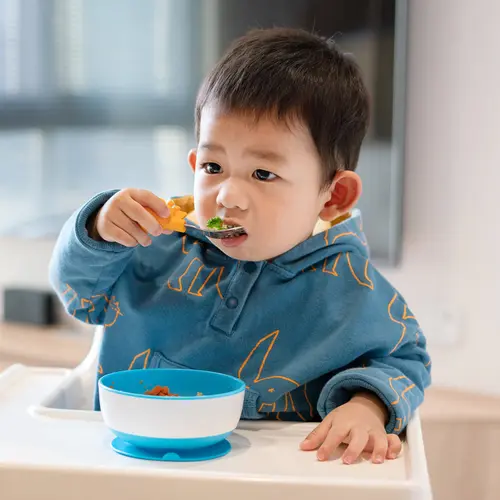Lunch often gets lost in the hustle and bustle of getting kids off to school in the morning. You may prefer to give your child money for lunch rather than pack a midday meal. But it's worth reconsidering bag lunches because they often far healthier than standard cafeteria fare.
To make sure your child actually eats the healthy lunches you provide, try this advice from Hillary Wright, MEd, RD, a Boston-based nutritionist at Harvard Vanguard Medical Associates and the mother of three boys.
Make the Grade With Lunch
"The most nutritious lunches include foods from at least three food groups, but that doesn't mean children must have the traditional sandwich, fruit, and milk for good health," says Wright. As long as youngsters eat a balanced and varied meal, it's perfectly fine to pack hummus, whole-grain crackers, and yogurt or leftovers from last night's dinner every day, as well as sandwiches.
The key is to respect your child's eating style and preferences. Some kids derive comfort from eating the same foods day in and day out while others balk at it. Work with your child, Wright says, and your child is less likely to drop lunch in the playground trash bin.
Get Kids Involved
Allowing children to choose and prepare their own lunch piques interest in the meal and makes it more likely kids will eat their own creations. Let your young child help make lunch the night before school for greater ease in the morning. You can help guide your children to the proper portions and healthy choices of whole grains, protein, and produce. Keep in mind, most elementary school-aged children are allowed a midmorning snack. Account for that when considering the amount of food you provide for lunch.
Make sure you have healthy fare on hand for your child to choose:
- Whole-grain breads or crackers
- Peanut and almond butters
- Light canned tuna fish
- Raw vegetables that can be cut into slices
- Fruits
- Encourage the kids to make sandwiches with whole-grain breads or bagels; tortillas; or colorful wraps. Try different sandwich fillings, such as tabouli mixed with feta cheese in a pita pocket, or a veggie burger.
For even greater buy-in, Wright recommends these simple steps:
- Let your children pick out their own lunchbox.
- Consider insulated lunch bags with room for a small freezer pack that allows you to send foods that must be kept cold, such as dip for fresh vegetables, yogurt, and orange juice.
- Or use larger lunch bags to avoid squishing foods.
- Have on hand small sturdy plastic containers for cut fruit, vegetables, dip, and lunch foods other than sandwiches.
Practical Lunch Tips
A sandwich made with lean meat, light tuna fish, or peanut butter and jelly; fruit or vegetables; and milk or 100% juice is a fine meal for a growing child's lunch. You can boost nutrition and tantalize a child's taste buds by adding shredded carrot, chopped celery, or water chestnuts to egg salad or tuna salad. Combine chopped grapes with diced chicken and mayonnaise for a tasty chicken salad. And don't forget this popular standby: Add a sliced banana or apple to peanut butter sandwiches.
Here are some other yummy and easy lunches that use foods from at least three of the food groups:- Tortilla wraps with shredded cheese, chopped chicken, and cut vegetables
- Egg salad, whole-wheat bagel, and fruit
- Whole-grain roll with butter or margarine, 2 hard boiled eggs, and carrot sticks
- 8 ounces of low-fat yogurt, whole-wheat crackers, and fruit
- 1-2 tablespoons of peanut butter, whole-grain crackers or bagel, and fruit or vegetables
- 1/2 cup low-fat cottage cheese or hummus, whole-grain crackers, and cherry tomatoes
- Bean-based soup or stew in a thermos, whole-grain roll with butter or margarine, and dried fruit
- 1-2 slices leftover thin crust cheese pizza and fruit or vegetables
Make It a Snap
"Children may have as little as 20 minutes to make it to the cafeteria, find their seats, eat, and clean up after themselves, so ease is the name of the game," Wright says. At some schools, kids eat on the playground, distracted by playing games.
So user-friendly foods are a must for lunch, especially for younger children who easily dismiss hard-to-eat foods that take time to get ready to eat. For example, older kids may be capable of peeling oranges and eggs in a flash, but younger ones are not. Sending a thermos? Make sure your child knows how to use it. Children with braces or other orthodontic devices often do better with foods like applesauce rather than whole apples, and prefer crackers or bread to bagels and bulky rolls, which are difficult to bite.
What's to Drink?
Milk and fortified 100% fruit juice are the best drinks for children at lunch, in that order. Up until age 9, kids need three 8-ounce glasses of milk every day, or an equivalent such as three cuts of yogurt. By their 9th birthday, they require four servings a day. Milk is one of the easiest ways for kids to meet their need for dairy foods. Encourage milk at school by providing milk money or packing containers of milk in the lunchbox. To make it a treat, offer low-fat chocolate milk. If you child refuses to drink milk at school, opt for 100% fruit juice fortified with calcium and vitamin D.
Don't Forget Fun
Every kid clamors for junk food, and an outright ban rarely works. So offer healthier alternatives. Pack these fun foods for a healthy treat:- Baked potato chips
- Homemade toasted pita bread chips
- Pretzels
- Trail mix or raisins
- Whole-grain cereal
- Nuts or soy nuts
- A smattering of chocolate chips
- Sunflower seeds
- Graham crackers
- Fig bars


